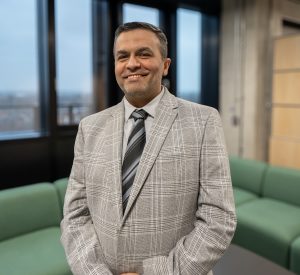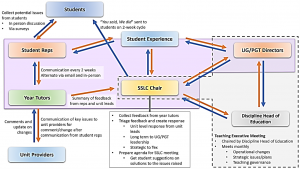Redesigning the Student-Staff Liaison Committee (SSLC) to Enhance Student Voice
 Abdullatif is a senior lecturer in chemical engineering in the Faculty of Science and Engineering. He has a background in the provision of taught modules, facilitating inquiry-based learning, student projects, and teaching laboratory modules. He is the Student-Staff Liaison Committee (SSLC) Academic Lead (since 2019) in the Chemical Engineering department where he has been focused on fostering a strong relationship between students and academics to enhance teaching quality and improve the overall student experience.
Abdullatif is a senior lecturer in chemical engineering in the Faculty of Science and Engineering. He has a background in the provision of taught modules, facilitating inquiry-based learning, student projects, and teaching laboratory modules. He is the Student-Staff Liaison Committee (SSLC) Academic Lead (since 2019) in the Chemical Engineering department where he has been focused on fostering a strong relationship between students and academics to enhance teaching quality and improve the overall student experience.
Strategic Planning and Collaboration
A core objective of my strategic plan was to promote collaboration between student reps and academics. This collaboration aimed to develop innovative teaching approaches and curricula, creating a dynamic learning environment that adapts to students’ evolving needs and puts student voice at the centre of teaching development.
I worked closely with Dr Thomas Rodgers, the former discipline head of education in our department, to establish a new mechanism for collecting feedback, addressing student issues, and getting student input as depicted in the flow chart below.

The new mechanism for collecting feedback and addressing student issues. The membership of the SSLC meetings is shown within the lilac box.
Operational Process
The students’ reps receive feedback from students on what they like or dislike about their academic experience; to do this they undertake discussions with the students in their year and run surveys. This dual approach makes sure that all students can input feedback, and feedback can be backed up by data. The student reps pass the feedback received from students onto the year tutors who then coordinate with the unit providers to create a response. Minor changes can be implemented directly, while larger or more general issues are then collated for discussion at the SSLC meetings. At the SSLC meetings it is made clear to student reps that their suggestions to solve the problems are important and there is discussion of solutions and actions for the issues raised. This feedback is then sent to all students so that they understand how their input is affecting their, and other students, experience.
Student Rep Recruitment, Training, and Support
Recognizing the crucial role of student reps, I introduced new guidelines for their selection, emphasizing active participation, attendance, and fulfilment of responsibilities. This led to increased commitment by reps as they could see the value in their role; it is not just a tick box activity for their CV.
Additionally, I provided training and support to enhance their communication, collaboration, and leadership abilities: this included a comprehensive handbook outlining the feedback collection process, their responsibilities, and expectations.
Addressing Challenges
- Inappropriate Comments
Instances of inappropriate comments from student reps were noted, often due to differing perceptions of appropriateness. In response, we established clear guidelines for communication within the committee, emphasizing appropriateness. Additionally, to address concerns about offensive content; year tutors and the SSLC lead now review comments, before being disseminated to staff and students.
- Student Reps’ Selection
To tackle issues like insufficient contribution, irregular attendance, and failure to fulfil responsibilities, we revamped our selection processes. Transparency is prioritized, and comprehensive training was implemented. Clear performance expectations are communicated to ensure that selected reps understand their roles and responsibilities.
- Ineffective Communication
Proactively promoting the positive impact of the SSLC has been a focus. Actively involving students in decision-making processes has been a key strategy to counteract potential negative influences on student engagement. It should be noted here that student feedback does not always lead to a change, if not appropriate, but it is still critical to explain to students why the current approach should not or cannot change.
- Low Response Rates for Surveys
To address the challenge of low survey response rates, we implemented a multi-faceted approach. This included increasing the visibility of surveys through various communication channels, offering incentives to motivate participation, and carefully planning survey timings to avoid survey fatigue. Redundant surveys were eliminated, and the purpose and importance of each survey were clearly communicated to reduce overload and enhance overall engagement. Student reps also explain the purpose of surveys to students in a dedicated 5 minutes in some lecture sessions.
Successful Showcases
This redesign of the SSLC process has been recognized as best practice in the University’s Annual Review of Teaching and Learning in January 2022. This process is driven by the philosophy that students are seen as partners in developing learning and feedback, creating a collaborative environment.
Some of the major successes are:
- Welcome Week Redesign
Collaborating with students, a key role in redesigning the Welcome Week was based on SSLC feedback. The new design facilitated more interactions, shorter tailored sessions, and positively impacted students’ transition to the university.
- Shaping the Delivery of Education
During the transition to blended learning and the challenges posed by the COVID-19 pandemic, student reps collaborated with lecturers to shape the delivery of education. Focus groups and surveys were conducted, leading to the creation of guidelines for teaching, now used as a template for developing digital learning resources and assessments across the department.
- Mitigating Issues during Year 3 Design Project
The groupwork aspect of the major third year project always fostered misunderstandings as students passed on their assumptions to each other by word of mouth. Open communication and collaboration with students and faculty during the year 3 design project helped mitigate misinformation, frustration, and uncertainty. By keeping students informed and engaging with the module lead, issues were addressed promptly, and measures were taken to prevent similar problems in future projects.
In conclusion, my time as the SSLC Academic Lead has been marked by transformative initiatives, recognizing the importance of collaboration, communication, and engagement in promoting a positive learning environment. These efforts align with the University of Manchester’s commitment to student success, academic excellence, innovation, diversity, and inclusivity.







0 Comments